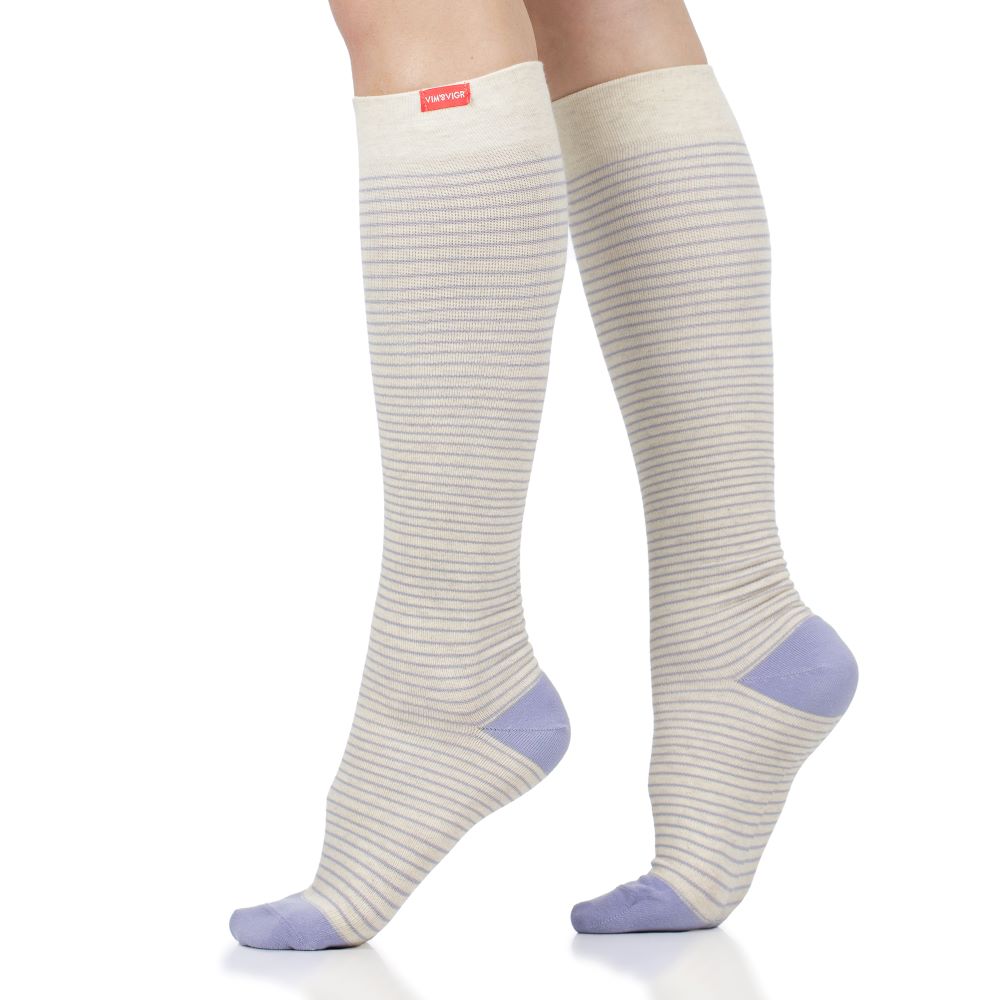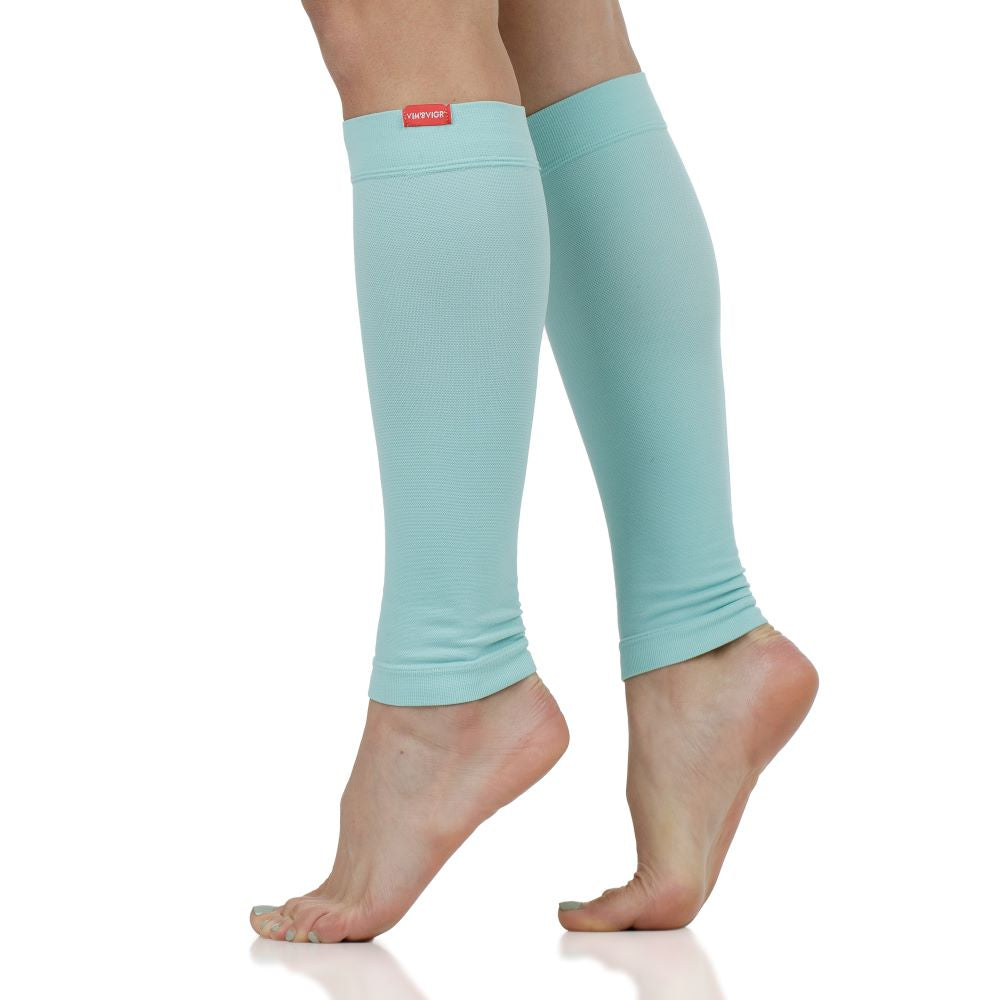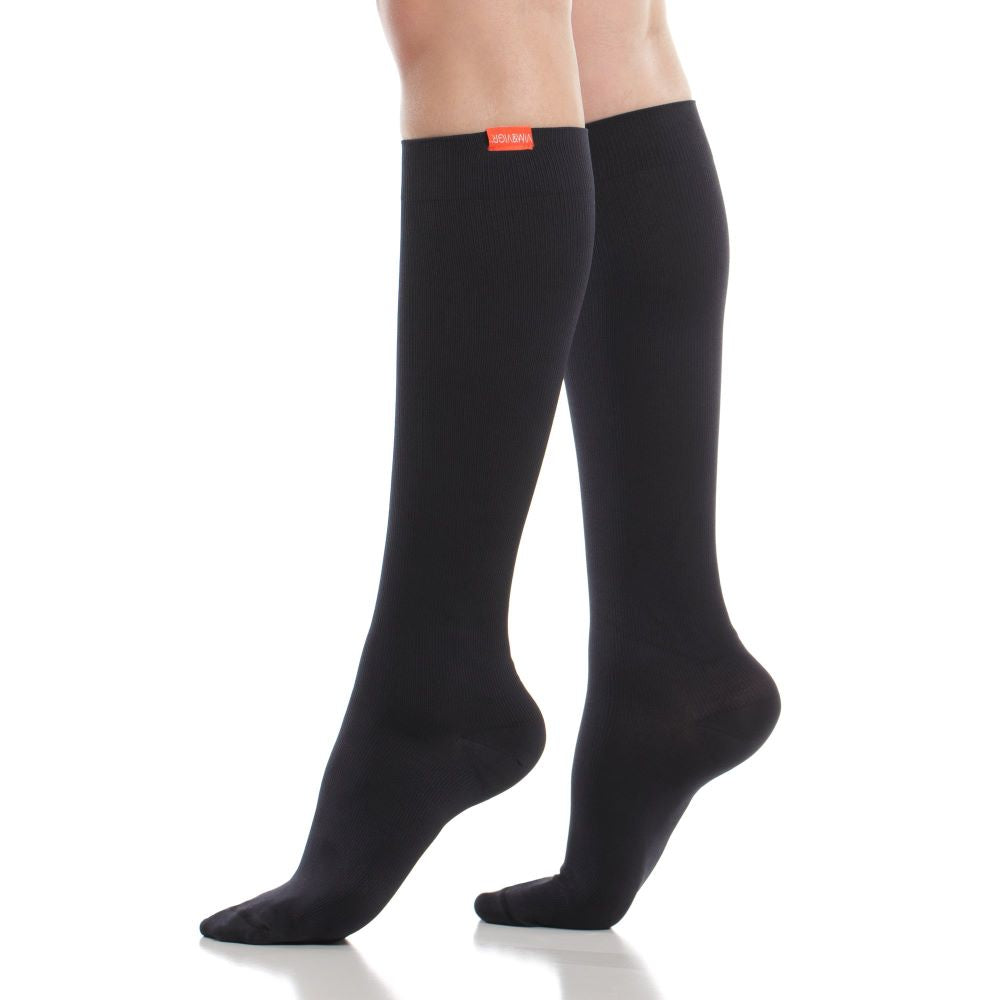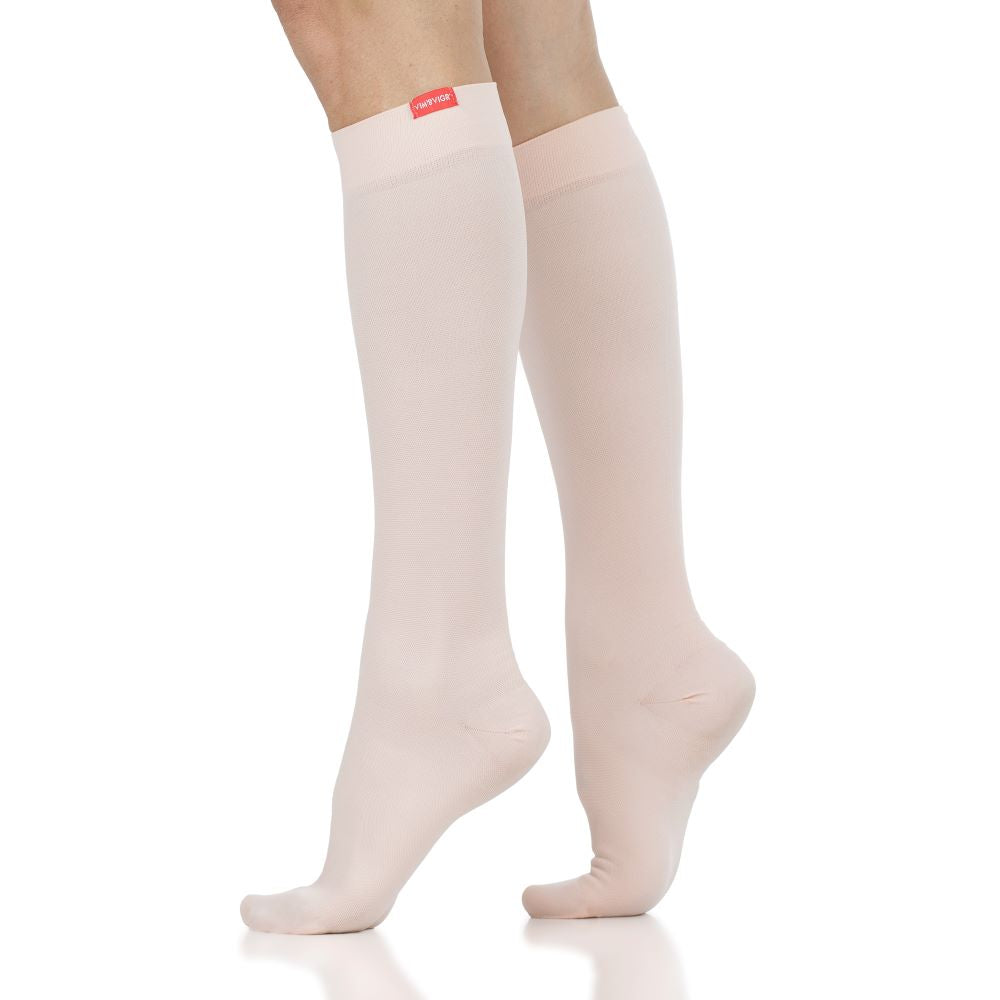Compression Socks for Neuropathy: A Complete Guide
Neuropathy affects so many diabetes sufferers, and there are lots of solutions that purport to help with that unwelcome “pins and needles” feeling. You may have access to treatments such as light therapy and electrical currents or gel pads. Compression socks can also be a huge help, reducing pain and improving stability and blood circulation.
Why and when should you use compression socks for neuropathy? Here’s a complete guide to cover peripheral neuropathy, the role and benefits of compression socks, and how to choose the best ones for you.
Regardless of the cause of your neuropathy, using compression stockings or socks, in conjunction with some other treatments and changes to your lifestyle, can make a huge difference to how you feel and to the health of your lower legs.

What is neuropathy?
While peripheral neuropathy refers to weaknesses, numbness and pain caused by damage to the nerves outside the brain spinal cord, it’s diabetic neuropathy in particular that’s responsible primarily for nerve damage in your legs and feet.
60-70% of diabetics have some nervous system damage, which has led to a perception that they’re the main ones affected by neuropathy. However, there are causes other than diabetes that can also lead to neuropathy. These include trauma (e.g. a car accident), repetitive stress, or autoimmune diseases, among others.
Having peripheral neuropathy is not just a cause for discomfort. Serious complications can follow, such as diabetic foot ulcers, gangrene, or even a condition called cardiovascular autonomic neuropathy (CAN). Moreover, research shows that elderly people who suffer with peripheral neuropathy also develop instability and, ultimately, can have falls and injuries.
Neuropathy should be treated by addressing the underlying causes (e.g. lifestyle changes), as well as by looking to ease its impact on the body. As part of this second category, compression socks offer a welcome relief – they’re often referred to as “diabetic socks” as well.
How Do Compression Socks Help with Neuropathy?
Compression socks are tightly-fitting socks that exert pressure on the legs and feet. Their main contribution is to promote blood flow to the lower limbs, allowing your foot muscles to relax and enabling you to get through long stints of standing up motionless or sitting for long periods of time. Compression socks combat edema, are great in work settings or for specialized jobs like nursing, and can help athletes as well.
It is important to use compression socks because research shows that nearly 90% of leg issues originate within the veins. By reducing swelling and enabling healthy blood flow in the legs and feet, they make a difference to those without medical concerns as well as to patients suffering from conditions like neuropathy.
The benefits of compression socks for neuropathy
There is evidence that shows multiple benefits of using compression socks for neuropathy, specifically addressing certain symptoms of peripheral neuropathy and of diabetes. They have been found to have a positive impact for those suffering from instability and balance difficulties. Furthermore, they improve overall blood circulation and can protect your lower legs from minor injuries. Studies also point to the positive role of compression socks against certain kinds of ulcers.
Stability and balance
People with low ability to sense the position of their joints, some female athletes and elderly people in general have all been studied to see the effect of wearing compression socks on their balance, with positive results. It is common to see stability issues in older patients, coupled with general lack of confidence in their motor skills and increased muscle weakness.
Given that poor stability and balance issues are directly connected with suffering from neuropathy, wearing compression socks will help those with the condition avoid falls and injuries and be more independent and mobile overall.
Blood circulation
Thanks to the positive effects of wearing compression socks on blood flow to the legs and feet, they are very likely to help against blood circulation problems which arise from peripheral / diabetic neuropathy. Wearing them to help reduce edema (swelling of the lower limbs), for example, has been very successful thanks to the increase in blood flow that avoids fluid build-up in the lower legs.
Research suggests that diabetes patients will benefit from wearing mild graduated compression socks. After all, they often struggle with swelling in the legs, feet and ankle area. Moreover, diabetic socks can prevent the formation of blood clots in your lower extremities, another important factor to consider in relation to poor circulation.
Extra protection
Most compression socks protect the wearer’s skin up to knee height and sometimes also feature special padding to keep the feet comfortable. This can be useful to help you avoid cuts and grazes that could easily develop into bigger injuries if they get infected.
Moreover, elderly patients or diabetic patients sometimes have reduced feeling in their lower legs, so there is a real risk that a small cut could go unnoticed. This might become a huge issue – infection or even gangrene – so having a genuine “shield” against such hazards is a welcome bonus.
Ulcers
Graduated compression socks have been found to help patients with eczema, varicose veins and ulcers. These kinds of injuries are prone to infection and healing them is crucial to prevent gangrene, which is one of the serious complications of peripheral neuropathy. Being able to protect yourself from them thanks to compression socks is an important benefit for diabetics and other sufferers.
All in all, patients with diabetic neuropathy report that the “pins and needles” feeling is significantly relieved by wearing compression socks. Additionally, the protection given by a pair of neuropathy socks and their support with stability are valuable benefits, too.
The best compression socks for neuropathy
So, what are the best compression socks for neuropathy? First off, you will need to know what to look for in a sock chosen specifically to help with its symptoms:
- Choose materials that reduce exposure to bacteria and germs. It is essential to keep your feet clean and protected to avoid any infections and the development of ulcers and ultimately gangrene. High-quality fabrics and good flexibility are paramount in your choice of socks.
- Ensure the socks are comfortable. There are few things worse than having rubbing or unwelcome seams causing discomfort as you try and prevent the unpleasant effects of neuropathy.
- Find a good fit. Compression socks are meant to exert pressure on your limbs, but go too far and you won’t feel any benefit from wearing them. It’s important to try the socks and ensure that they are tight-fitting, enough to stay up all day, but also not too tight so that they cause pain or bruising.
- Check the compression levels. For neuropathy patients, graduated medical-grade compression socks offer the best option.
It is important to note that compression socks come in varying pressure levels, expressed in mmHg. While products in a lower pressure range offer some degree of compression, they will not necessarily be as effective.
You should check with your doctor first, but the medical grade 30-40 mmHg compression socks are generally the best choice for people suffering from peripheral neuropathy.
Shop fashionable compression socks in levels 15-20 mmHg, 20-30 mmHg, 30-40 mmHg Here!
Neuropathy relief tips
In addition to wearing medical-grade compression socks as prescribed by your doctor, you could also address neuropathy symptoms by following these tips:
- Take care of your feet daily. This includes checking for blisters, cuts or calluses and treating them accordingly, to prevent any serious injuries or infections. Proper foot care is one of the first steps towards better lower limb health.
- Exercise regularly. Going for walks three times a week can improve your circulation, while also developing muscle strength and helping you attain low blood sugar levels (especially important for diabetics). In the longer term, gentle exercise classes like yoga and tai-chi can be beneficial – they can also help develop better balance.
- Avoid alcohol consumption. It can have detrimental effects on your health in the long term, raise blood sugar levels, prevent you from losing weight and interfere with your blood circulation.
- Quit smoking. It has been proven that cigarette smoking affects circulation and therefore increases the risk of foot problems and neuropathy-related pain.
- Eat healthily. It’s important to have a balanced diet with lots of fruits, vegetables, whole grains and lean protein, to prevent any unwanted side-effects from peripheral neuropathy.
- Take a warm bath to relieve pain. Warm water increases blood flow to the legs and helps relieve stress and tension, so it’s a great way to combat neuropathy symptoms.
Compression socks for neuropathy: Your key to healthier comfort
Neuropathy cannot be cured, but there are options for those suffering from painful legs and feet, “pins and needles” and general discomfort. Wearing compression socks, especially those that are of a higher pressure level, after discussing this option with your doctor, will help your blood flow and will also protect your lower limbs from cuts and other injuries. A pair of good-quality graduated compression socks will relieve your “pins and needles” and will prevent swelling and discomfort after long periods standing or sitting (e.g. during a flight).
FAQ
*Please consult with your doctor on your condition, this is not medical advice.
- Does compression help neuropathic pain?
- Compression can be helpful for neuropathic pain. Compression socks are tightly-fitting socks that exert pressure on the legs and feet. Their main contribution is to promote blood flow to the lower limbs, allowing your foot muscles to relax and enabling you to get through long stints of standing up motionless or sitting for long periods of time. By reducing swelling and enabling healthy blood flow in the legs and feet, they make a difference to those without medical concerns as well as to patients suffering from conditions like neuropathy.
- What level of compression is best for neuropathy relief?
- For neuropathy patients, graduated medical-grade compression socks offer the best option. It is important to note that compression socks come in varying pressure levels, expressed in mmHg. While products in a lower pressure range offer some degree of compression, they will not necessarily be as effective. You should check with your doctor first, but the medical grade 30-40 mmHg compression socks are generally the best choice for people suffering from peripheral neuropathy. VIM & VIGR Compression offers 30-40 mmHg compression socks in varying patterns and fabrics to ensure high quality, stylish compression.
- How long should you wear compression socks if you have neuropathy?
- It is recommended to consult a doctor for your specific situation. Generally, it is safe to wear compression socks for 24 hours upon doctors’ approval. In fact, the National Health Service in the United Kingdom recommends that surgery patients wear compression stockings as much as possible, day and night, after surgery.
- Are there any side effects of wearing compression socks for neuropathy?
- Compression socks are generally safe, they can cause you pain or even cut off your circulation if you don't wear the proper size. The pressure also can cause minor bruising or skin ulcers, and tightly fitting socks also can cause dry skin, redness, and itching. These concerns are why VIM & VIGR offers 6 different sizes (including widecalf compression socks) to ensure absolute comfort.
- Can compression socks worsen nerve pain?
- No, compression socks can help relieve nerve pain by reducing swelling, which is why compression socks are recommended for neuropathic pain.
Make sure to check whether compression socks are right for you and try a pair to ensure best fit and comfort levels. To find out more, join our mailing list and benefit from a welcome offer, while staying up to date with all the information you need to know around compression and treating your legs and feet.
Find your new favorite compression socks for neuropathy today!





















How do I know what size to get? Do I measure my calf? Also, my neuropathy is in my foot, not calf and ankle. Will these help my foot neuropathy? Thank you.
Thank you, this is great information and it has helped me a lot.
How long should you wear compression socks daily,also can or should you wear them overnight?
Hi Thomas,
Thank you for reaching out. Feel free to click the link below for the medical grade 30-40 mmHg compression socks to place your order:
https://vimvigr.com/collections/30-40-mmhg-compression-socks
Please let us know if there’s anything else we can assist you with.
Take care & stay safe,
VIM & VIGR Customer Service
Hi Linda,
Thank you for reaching out. You may consult a neurologist, a doctor who specializes in diseases of the nerves.
Please let us know if there is anything else we can assist you with.
Take care & stay safe,
VIM & VIGR Customer Service
Leave a comment